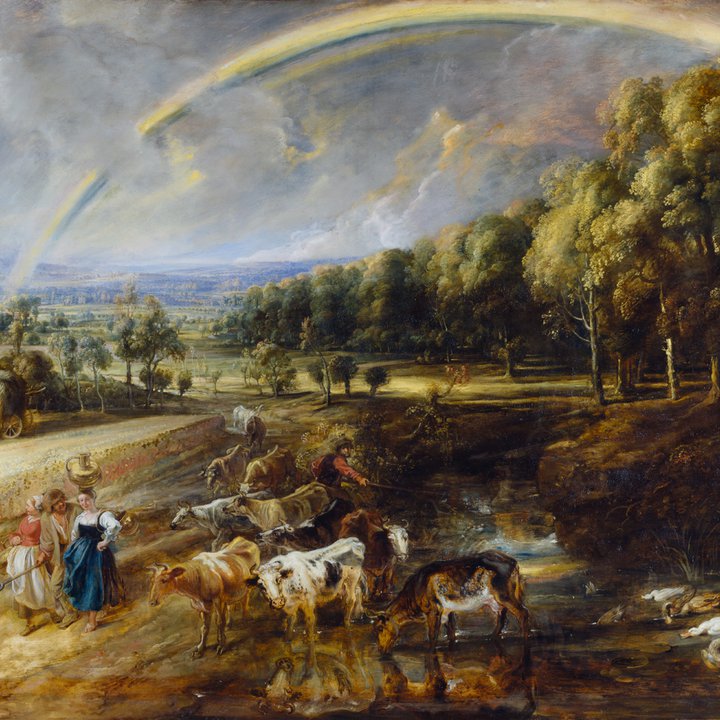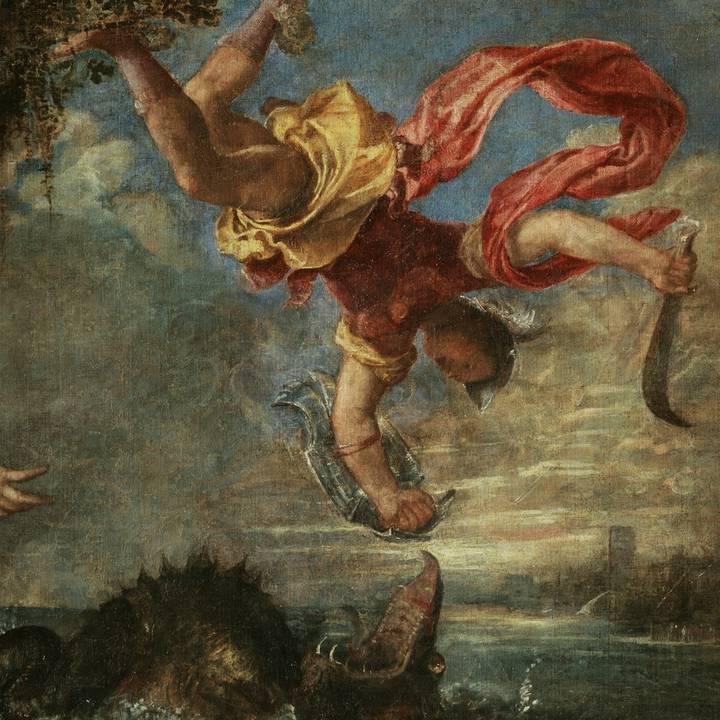RUBENS'S GREAT LANDSCAPES
In our exhibition we are celebrating a companion pair which are two of Rubens’s great panoramic landscapes: A View of Het Steen in the Early Morning (The National Gallery), and The Rainbow Landscape (The Wallace Collection). During his career, Rubens painted landscapes both great and small in scale, but the great panoramic format was one he developed with remarkable verve later in his life.
Following a Netherlandish tradition, the support he preferred to use for his landscapes was oak panel, the smooth surface of which allowed for expressive, textural brushwork and rich detail, and vibrant colour. These usually consisted of several smaller boards, assembled by a panel maker, and in some cases they were expanded at Rubens’s request with additional boards fixed to the existing panels.
Rubens painted his landscapes for his own pleasure, not on commission, and perhaps relishing the artistic challenges they presented to him. The evidence is that he focused on landscape with renewed vigour in the time following his purchase of his country estate near Mechelen, Het Steen, in 1635. Rubens’s nephew Philip reported that the artist spent his time at Het Steen in solitude, observing the landscape at different times of day ‘up to the horizon.’
This was the period when he painted or completed a group of ‘great landscapes’ as they were described in the catalogue of his paintings drawn up on his death in 1640. They include Het Steen and The Rainbow Landscape, and the Stormy Landscape with Philemon and Baucis, in the Kunsthistorisches Museum, Vienna. Another painting which is closely associated with the two former paintings is the panoramic view of the landscape surrounding Rubens’s estate, now at the Barber Institute, Birmingham. In their variety, these four paintings demonstrate the range of his imaginative powers and his breathtaking technical skill.
Het Steen is Rubens’s only panoramic landscape that includes the castle, his pride and joy, displayed in a prominent position. Rubens elevates the horizon line and adds contours to the landscape to offer an expansive view of the estate, demonstrating his detailed, land-owner’s knowledge of the lie of the land. Rubens must have used the tower (to the north of the castle) as a vantage point to see far into the distance. Its companion piece, The Rainbow Landscape, shows a different view of the estate, taking in a stand of wheat, hayfields, and the distant meadows.
Both paintings show an idealised vision of farming and rural life: going to market, shooting partridges, milking cows, harvesters untroubled by rainstorms. In The Rainbow Landscape, the pervading sense of peace and harmony is emphasised by the presence of an enormous rainbow. Humanity here is in harmony with Nature, which in times of peace, as here, appears endlessly productive. The rainbow, one of Rubens’s favourite motifs (he is said to have painted it in seven different compositions) stretches across the sky, as a Biblical symbol of the covenant between man and God after the flood, and of peace and hope.
The Barber painting, on the other hand, is a ‘pure’ landscape, with only the faintest human presence, in the form the small staffage figures of a shepherd and his flock. The emphasis instead is on the atmosphere of the low-lying landscape that surrounded Het Steen, which is flooded in places. The drama of the painting lies in the blustery sky reflecting the low rays of the sun. The view seems to be taken from the middle ground, without the transition to the immediate, detailed foreground with large forms (tree trunks and undergrowth) that we find in the other three paintings.
The Stormy Landscape, now known to have been completed around the same time as Het Steen and The Rainbow Landscape, contrasts with them in obvious ways. It is a very dramatic scene, intended to elicit a very different emotional response from the viewer: excitement and awe, rather than serenity and thankfulness.
This scene is not set in the lush meadows of Brabant but in a wild, mountainous region of a mythical land. It is a rarely depicted episode from the tale of Philemon and Baucis, as told by Ovid in the Metamorphoses (I, 260-312): a poor old couple gave hospitality to the disguised Jupiter and Mercury, who had been shunned by the richer households in the land of Phrygia (a region of modern-day Turkey). The gods punished those who had rejected them with a terrible flood, but spared their hosts, whom they took to observe the scene from a safe distance. It is one of the few landscapes by the artist to include mythological figures (see also Ulysses and Nausicaa, Pitti Palace, Florence).
Nature is a powerful adversary here, overwhelming the scene, which includes the small crouching couple and the deities, who observe the catastrophe they have wrought upon the land. Particularly striking are the angry, stormy sky and the mighty torrent of the flooded river which has left drowned people and animals in its wake. Unexpectedly, from this hellish scene, a small rainbow arises, created by spray from the torrent. It was identified in the inscription that accompanied the engraving made after it as the guise of Iris, messenger of the gods, in this case, Jupiter and Mercury. Here in this epic drama, the rainbow in the bottom extremity of the painting rather than in its usual position in the sky seems to stand for the inversion of the natural order.
When The Stormy Landscape was recently conserved, it was discovered that, like Het Steen and The Rainbow Landscape, it began not in the monumental format we see today, but rather as a smaller composition that was enlarged in two stages of expansion. Rubens seems to have returned to a composition that he had painted about a decade earlier, which he transformed from a ‘pure’ mountainous scene (now at the centre) into a landscape with figures and subsequently into the ambitious mythological narrative we see today. This final iteration is thought to have been painted in the years that Rubens was also engaged with Het Steen and The Rainbow Landscape. These three paintings are the culmination of his remarkable achievements as a landscape painter.
For further information on the companion pair and the evolution of their compositions, see Lucy Davis, Rubens. The Two Great Landscapes (2020), and for the Stormy Landscape see: Gerlinde Gruber and Elke Oberthaler, eds., Rubens’s Great Landscape with a Tempest. Anatomy of a Masterpiece (2020).



